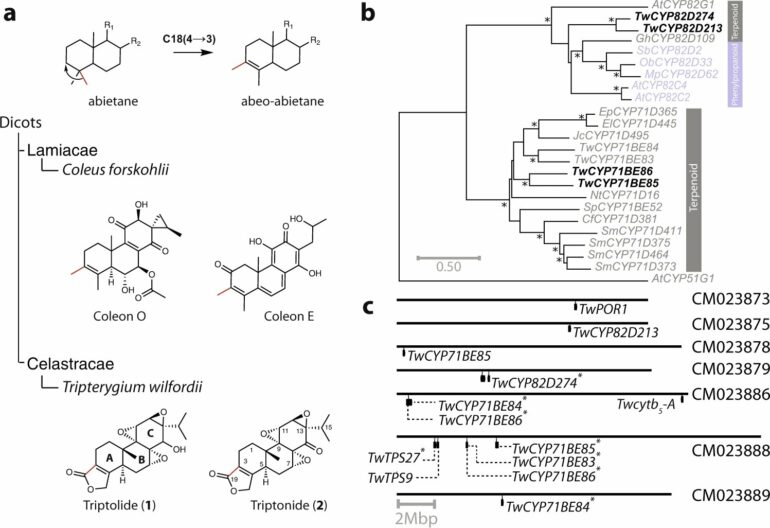University of Copenhagen researchers have gotten yeast cells to brew triptolide, a substance typically extracted from a rare Chinese plant. Their research makes it possible to control rats with the substance on a large scale—both humanely and sustainably.
The father of Indiana Jones is famously terrified of them. And as spreaders of the Black Death and many other a horrid disease throughout history, they have terrorized more people than any human reign of terror. Nevertheless, their populations continue to boom, from Copenhagen to Singapore.
Rats thrive wherever there are humans. Together with us, they have colonized every continent except Antarctica. Destruction and disease comes in their wake. Yet our fight against them has proven both ineffective—partly due to resistance—and dangerous to ecosystems.
Using research from the Department of Plant and Environmental Sciences and spinout company TriptoBIO, an American company called SenesTech is now ready to spread an effective and environmentally friendly alternative on a much larger scale. And, because the product impedes the ability of rats to reproduce instead of killing them, it is humane.
“I joke a bit about this being a ‘woke’ product. It is sustainable, ethical to animals and even strong on gender equality, as male rats are also targeted by this contraception. They become infertile for about a month after consuming it, which causes rat populations to drop dramatically,” says Johan Andersen-Ranberg of the Department of Plant and Environmental Sciences, one of TriptoBIO’s founders.
A rare Chinese plant
Rats are lured to a sweet and sticky liquid from a feeder developed by the American company. Among the sweet rat treat’s active ingredients is triptolide, a substance that makes the liquid a kind of contraceptive stew for male and female rats alike.
The substance is derived from Tripterygium wilfordii, also known as Thunder god vine, a rare Chinese vine plant that is harvested in the mountains by local gatherers. According to Andersen-Ranberg, in addition to being difficult to find and unstable in delivery, the plant also produces very little of the active substance. So little, that its value by weight is fifteen times more than gold.
Now, the UCPH researchers have found the enzymes and genes in the plant responsible for the substance, decoded the relevant DNA, and encoded it in the genetic material of a yeast. By doing so, they have been able to ferment and produce the substance in a much faster, more stable and, not least, cheaper way.
The breakthrough was a lucky side experiment
The researchers had an idea that a certain group of enzymes—proteins that speed up certain chemical reactions—were behind the biosynthesis of triptolide in the Tripterygium wilfordii plant.
They started “fishing” for the crucial enzymes among roughly 300 types of cytochrome p450 enzymes found in the plant. But their initial search was met with discouraging results. In the end, it was a unique combination of P450 enzymes that delivered success.
With a good mix of a scientific serendipity and solid plant chemistry know-how, the key enzymes were discovered by chance in a side experiment.
“Well, it was a side experiment where I thought, we have some material to spare, so let’s just try to see if this works. As it turned out, the main line of investigation didn’t work at all. But this little side effort over in the corner, it just showed everything that we had hoped to see. Once we had the key enzymes, the pieces fell into place,” says Johan Andersen-Ranberg.
The researchers quickly identified the remaining enzymes whose interactions are essential for the biosynthesis of triptolide. They then took the genes with the DNA recipe for the plant enzymes and inserted into them a yeast cell’s genetic material, which acts as a self-replicating chemical factory. A biological triptolide factory—or brewery to be more precise—was created.
“Now we can create triptolide a bit like how you would brew beer. Put simply, we feed the yeast with sugar in tanks and are awarded with this precious substance at the other end,” explains Johan Andersen-Ranberg.
Current methods are extremely toxic
Extremely potent poisons are now used for rat control. But rats are cunning critters. If a poison encountered by a rat is not strong enough to kill it, the rodent will quickly find out how to avoid human traps. Furthermore, in Denmark among other places, many rats have developed resistance to milder poison variants.
The powerful poisons damage ecosystems and degrade very slowly, often taking a year before their effect is halved. During this time, birds and any scavengers that eat the rats can also receive lethal doses and carry the poison with them into the wild.
The authorities are aware of these “extremely toxic” current remedies, as the Danish Environmental Protection Agency refers to them, but allow them for a lack of alternatives and because the danger posed by rats is considered to be greater.
While nearly seven hundred years have passed since the Black Death here in Europe, as carriers of disease, rats are still considered a threat to public health. Elsewhere in the world, the problem is much greater. They are also responsible for significant economic damage. Their burrowing can damage sewer lines and even cause a home’s foundation to shift, making them a source of expensive to repair damages.
Extremely toxic
Anticoagulants are the most commonly used rat poisons today. But like the newer and less-used alternatives, they are extremely toxic and environmentally harmful.
With regards to the approval of a new poison, the Danish Environmental Protection Agency wrote in 2020 about existing rat poisons: “Cholecalciferol, like anticoagulants, is extremely toxic and, in principle, undesirable in the environment. But as there are currently no alternatives effective against rodents, they are permitted to be used as pesticides because rats in particular are considered such a serious public health problem that it is necessary to ensure effective control.”
First Manhattan, then the world
The yeast developed by the researchers can be scaled to produce enough triptolide that even a problem as global and pervasive as rat control can realistically be solved with TriptoBIO as a supplier of this valuable substance.
“With our research and the yeast, we’ve now developed, we can ensure supply and get the price of triptolide down to a level where it is realistic for this environmentally friendly and ethical alternative to existing rat control to be widely used. We are starting in the US, but are optimistic about getting the rest of the world on board,” says Johan Andersen-Ranberg, who continues:
“Initially, we will probably only make a few kilos of the substance. But when rat control using our substance grows as large as demand leaves us to believe that it will, we will be producing it by the ton. And we’ll be ready. On top of that, there are plenty of other perspectives for this substance. A number of other projects are also under development in which triptolide is a necessary ingredient. Fortunately, we can easily scale up,” says the researcher.
Rat contraception
ContraPest, the American company SenesTech’s product, has two active ingredients that act as rat contraceptives—4-vinylcyclohexene dioxide (VCD) and triptolide.
Both ingredients limit the fertility of female rats, while triptolide in particular acts as contraception for male rats by impairing their sperm production.
While the product is already being used in the United States, Europe will have to wait a bit longer, as this type of rat control has yet to make its way through EU approval procedures.
The study is published in the journal Nature Communications.
More information:
Nikolaj Lervad Hansen et al, Tripterygium wilfordii cytochrome P450s catalyze the methyl shift and epoxidations in the biosynthesis of triptonide, Nature Communications (2022). DOI: 10.1038/s41467-022-32667-5
Provided by
University of Copenhagen
Citation:
Study: Contraception is the future of rat control (2023, February 20)



